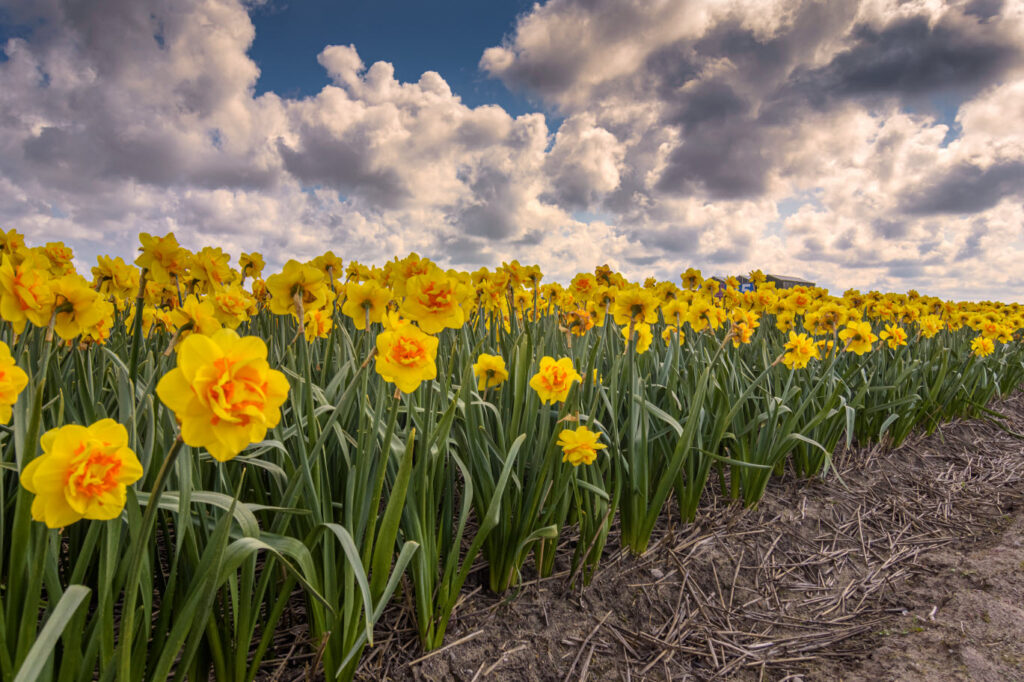“Mother, you must come and see the daffodils before they are over.” This is how Jaroldeen Asplund Edwards begins her narrative of the experience that led her to the ‘daffodil principle’. Somewhat reluctantly, she agreed to undertake the two-hour drive the following week…
The weather was daunting and the road narrow and winding. After a hair-raising journey through mist and fog, she arrived at her daughter’s house, swearing she wouldn’t drive another inch!
“I’ll drive,” Carolyn offered. “I’m used to this.” I promise you will never forgive yourself if you miss this experience.”
They parked next to a little stone church at the top of the mountain. On the far side of the church, was path, with an inconspicuous, lettered sign ‘Daffodil Garden’.
Jaroldeen continues her narrative:
I followed Carolyn down the path as it wound through the trees. The mountain sloped away from the side of the path in irregular dips, folds and valleys, like a deeply creased skirt.
Live oaks, mountain laurel, shrubs and bushes clustered in the folds and in the gray, drizzling air, the green foliage looked dark and monochromatic. I shivered. Then we turned a corner of the path and I looked up and gasped. Before me lay the most glorious sight, unexpected and completely splendid. It looked as though someone had taken a great vat of gold and poured it down over the mountain peak and slopes, where it had run into every crevice and over every rise. Even in the mist-filled air, the mountainside was radiant, clothed in massive drifts and waterfalls of daffodils. The flowers were planted in majestic, swirling patterns, great ribbons and swathes of deep orange, white, lemon yellow, salmon pink, saffron and butter yellow.
Each different-coloured variety (I learned later that there were more than 35 varieties of daffodils in the vast display) was planted as a group so that it swirled and flowed like its own river with its own unique hue.
In the centre of this incredible and dazzling display of gold, a great cascade of purple grape hyacinth flowed down like a waterfall of blossoms framed in its own rock-lined basin, weaving through the brilliant daffodils. A charming path wound throughout the garden. There were several resting stations, paved with stone and furnished with Victorian wooden benches and great tubs of coral and carmine tulips. As though this were not magnificence enough, Mother Nature had to add her own grace note — above the daffodils, a bevy of western bluebirds flitted and darted, flashing their brilliance. These charming little birds are the colour of sapphires with breasts of magenta red. As they dance in the air, their colours are truly like jewels above the blowing, glowing daffodils. The effect was spectacular.
It did not matter that the sun was not shining. The brilliance of the daffodils was like the glow of the brightest sunlit day. Words, wonderful as they are, simply cannot describe the incredible beauty of that flower-bedecked mountaintop.
Five acres of flowers! (This too I discovered later when some of my questions were answered.) “But who has done this?” I asked Carolyn. I was overflowing with gratitude that she brought me — even against my will. This was a once-in-a-lifetime experience.
“Who?” I asked again, almost speechless with wonder, “And how, why and when?”
“It’s just one woman,” Carolyn answered. “She lives on the property. That’s her home.” Carolyn pointed to a well-kept A-frame house that looked small and modest in the midst of all that glory.
We walked up to the house, my mind buzzing with questions. On the patio, we saw a poster.” ‘Answers to the Questions I Know You Are Asking’ was the headline. The first answer was a simple one: “50,000 bulbs,” it read. The second answer was: “One at a time, by one woman, two hands, two feet, and very little brain.” The third answer was: “Began in 1958.”
There it was. The Daffodil Principle.
“For me that moment was a life-changing experience. I thought of this woman whom I had never met, who, more than 35 years before, had begun — one bulb at a time — to bring her vision of beauty and joy to an obscure mountaintop. One bulb at a time.
There was no other way to do it. One bulb at a time. No shortcuts — simply loving the slow process of planting. Loving the work as it unfolded.
Loving an achievement that grew so slowly and that bloomed for only three weeks of each year. Still, just planting one bulb at a time, year after year, had changed the world.
This unknown woman had forever changed the world in which she lived. She had created something of ineffable magnificence, beauty and inspiration.
The principle her daffodil garden taught is one of the greatest principles of celebration: Learning to move toward our goals and desires one step at a time often just one baby-step at a time learning to love the doing, learning to use the accumulation of time.
When we multiply tiny pieces of time with small increments of daily effort, we too will find we can accomplish magnificent things. We can change the world.
“Carolyn,” I said that morning on the top of the mountain as we left the haven of daffodils, our minds and hearts still bathed and bemused by the splendours we had seen, “it’s as though that remarkable woman has needle-pointed the earth! Decorated it. Just think of it, she planted every single bulb for more than 30 years. One bulb at a time! And that’s the only way this garden could be created. Every individual bulb had to be planted. There was no way of short-circuiting that process. Five acres of blooms. That magnificent cascade of hyacinth!
“All, just one bulb at a time.”
The thought of it filled my mind. I was suddenly overwhelmed with the implications of what I had seen. “It makes me sad in a way,” I admitted to Carolyn. “What might I have accomplished if I had thought of a wonderful goal 35 years ago and had worked away at it ‘one bulb at a time’ through all those years. Just think what I might have been able to achieve!”
My wise daughter put the car into gear and summed up the message of the day in her direct way. “Start today,” she said with the same knowing smile she had worn for most of the morning. Oh, profound wisdom!
It is pointless to think of the lost hours of yesterdays. The way to make learning a lesson a celebration instead of a cause for regret is to only ask: “How can I put this to use today?”
Source: Jaroldeen Asplund Edwards
https://www.amazon.com/Daffodil-Principle-Jaroldeen-Edwards/dp/1590382242



